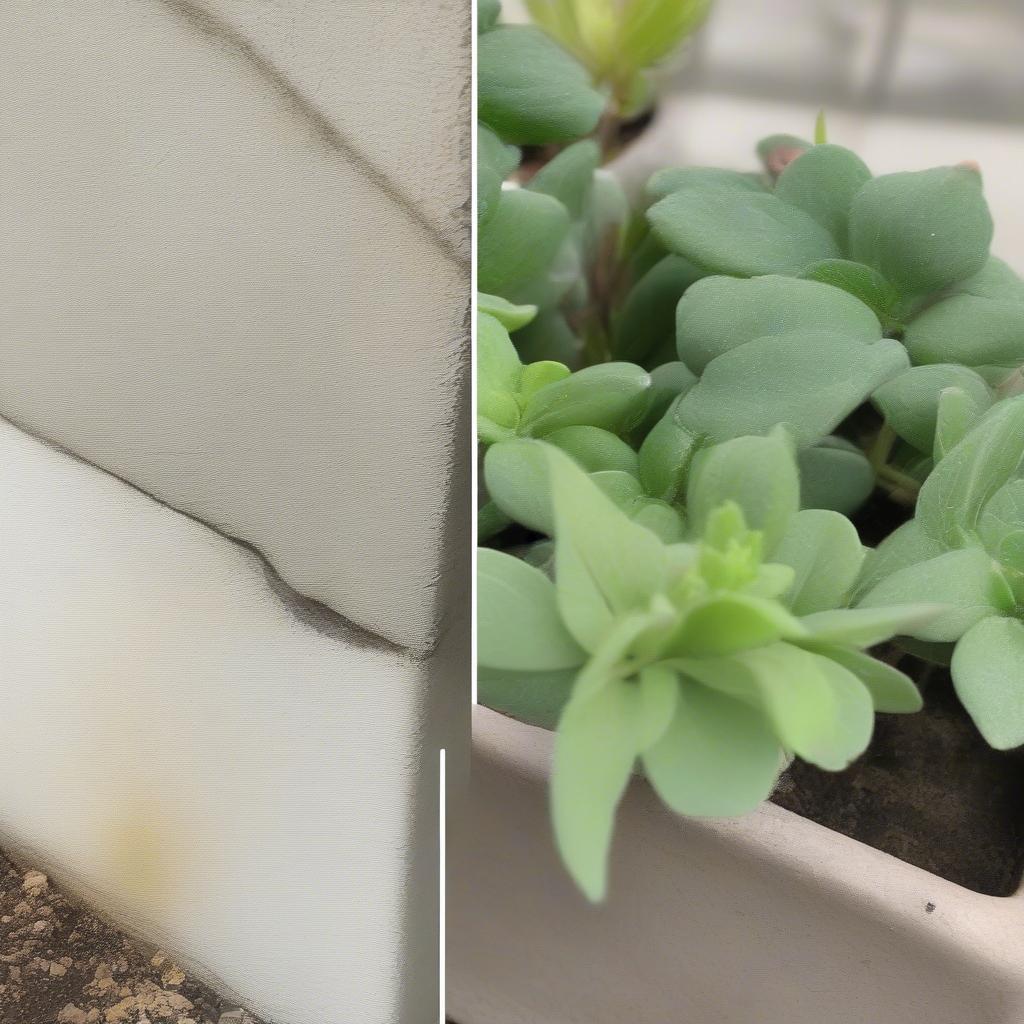Cleaning concrete planters is essential for maintaining their appearance and longevity. Whether you’re dealing with stubborn algae, mineral deposits, or just everyday grime, this guide will provide you with effective cleaning methods to keep your concrete planters looking their best. After all, a clean planter enhances the beauty of the plants it houses.
Understanding the Importance of Cleaning Concrete Planters
Concrete is a porous material, meaning it absorbs water and other substances from its surroundings. Over time, this can lead to unsightly stains, mold, mildew, and mineral buildup, especially in outdoor settings. Regular cleaning not only improves the aesthetics of your planters but also prevents the growth of harmful microorganisms that can affect your plants’ health.  Cleaning concrete planters with brush and soap
Cleaning concrete planters with brush and soap
Basic Cleaning for Everyday Grime
For routine cleaning, a simple solution of water and dish soap works wonders. Mix a few drops of mild dish soap into a bucket of warm water. Use a stiff-bristled brush to scrub the planter’s surface, paying attention to any crevices or textured areas. Rinse thoroughly with clean water and allow to air dry. This is a quick and easy way to remove surface dirt and dust. For more stubborn dirt, you can add a bit of baking soda to the soapy water mixture for extra scrubbing power.
Tackling Tough Stains and Mineral Deposits
Sometimes, basic cleaning isn’t enough to remove stubborn stains or mineral deposits. In these cases, a vinegar solution can be very effective. Mix equal parts white vinegar and water in a spray bottle. Spray the solution onto the affected areas and let it sit for 15-20 minutes. Scrub with a brush and rinse thoroughly. The acidity of the vinegar helps to break down mineral deposits and remove tough stains.  Removing mineral deposits with vinegar solution
Removing mineral deposits with vinegar solution
Removing Algae and Mold
Algae and mold can thrive in damp, shady areas, making concrete planters a prime target. A bleach solution is an effective way to eliminate these unwanted growths. Mix one part bleach with ten parts water. Apply the solution to the affected areas and let it sit for about 30 minutes. Scrub with a brush and rinse thoroughly. Always wear gloves and eye protection when working with bleach, and ensure the area is well-ventilated. Never mix bleach with ammonia, as it creates toxic fumes.
How to Clean Concrete Planters with Efflorescence
Efflorescence, those white, chalky deposits that often appear on concrete, can be unsightly. A specialized efflorescence remover can be purchased from most hardware stores. Follow the manufacturer’s instructions for application. Alternatively, a muriatic acid solution can be used, but this is a more aggressive approach and should be handled with extreme caution. If you choose to use muriatic acid, wear protective gear and follow the safety precautions on the product label. It’s essential to thoroughly rinse the planter afterward to neutralize the acid.
Tips for Maintaining Clean Concrete Planters
- Regular Cleaning: Clean your concrete planters regularly, at least once a month, to prevent the buildup of dirt and grime.
- Proper Drainage: Ensure your planters have adequate drainage to prevent waterlogging, which can contribute to algae and mold growth. Consider adding a layer of gravel to the bottom of the planter to improve drainage. A footed planter might offer better drainage.
- Protective Sealers: Applying a concrete sealer can help prevent staining and make future cleaning easier. Check out our selection of concrete oblong planters.
- Seasonal Cleaning: Give your planters a deep cleaning at the beginning and end of each growing season to remove any accumulated debris. You might also consider a log planter for a natural look.
Expert Insights
John Smith, a renowned landscape designer, emphasizes the importance of regular cleaning: “Clean concrete planters not only look better, but they also contribute to a healthier environment for your plants. Regular maintenance helps prevent the growth of harmful microorganisms and ensures your planters last for years.”
Maria Garcia, a horticultural expert, adds, “When choosing a cleaning method, consider the type of stain and the material of your planter. Always test any cleaning solution on a small, inconspicuous area first to ensure it doesn’t damage the finish.”
Conclusion
Knowing How To Clean Concrete Planters is crucial for preserving their beauty and extending their lifespan. By following these simple cleaning tips, you can keep your concrete planters looking pristine and provide a thriving environment for your plants. Regular cleaning and proper maintenance will ensure your concrete planters remain a beautiful addition to your garden or home for years to come.
FAQs
- How often should I clean my concrete planters?
- What’s the best way to remove algae from concrete planters?
- Can I use a pressure washer to clean my concrete planters?
- How do I prevent efflorescence on my concrete planters?
- What type of brush is best for cleaning concrete planters?
- Can I paint my concrete planters after cleaning them?
- What’s the best way to clean concrete planters with delicate plants?
 Cleaning a concrete planter with plants
Cleaning a concrete planter with plants
If you need assistance, please contact us at My Dinh, Hanoi, Vietnam or San Francisco, CA 94105, USA. We have a 24/7 customer service team.


